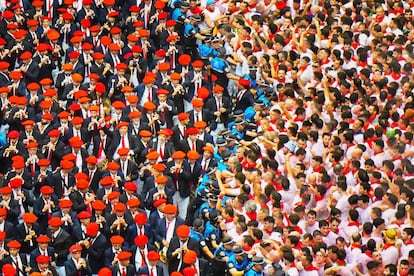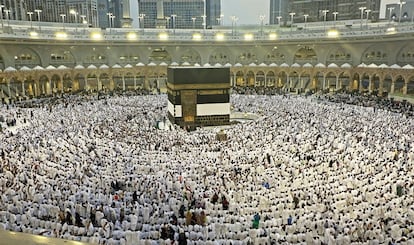How the physic laws of the San Fermín crowds could prevent stampedes
Crowds reach a critical point where individual movement is overtaken by a collective dynamic, causing the mass to adhere to Newton’s third law
Every July 6, at 10 a.m., Pamplona’s municipal police open the town hall square to crowds that move freely until around half an hour before the chupinazo, the rocket signaling the start of Spain’s world-famous San Fermín festival, also known as the Running of the Bulls. At that moment, the crowd seems chaotic, but a new study published in Nature reveals that it actually follows fluid dynamics, with circular movements formed by increasingly larger subgroups orbiting in 18-second cycles. Physicists have found that the San Fermín crowd adheres to Newton’s third law, offering insights into crowd behavior that could potentially help prevent tragedies in large gatherings.
At 11:30 a.m., with more than 5,000 people packed into the 50 by 20-meter square, the crowd reaches a density of up to nine people per square meter. Once the density hits four pedestrians per square meter, something changes. “After a critical density, the crowd begins to move in spontaneous oscillations,” explains Denis Bartolo, a professor at the École Normale Supérieure in Lyon and co-author of the study. “Even without external cues, people start moving synchronously,” adds Bartolo, a physicist specializing in mass phenomena.
Using rooftop cameras, the team of physicists studied the dynamics of the crowd during the opening ceremony of the 2019, 2022, 2023, and 2024 edition of the San Fermín festival. Every year, the same pattern emerged: once the crowd density reached a certain threshold, individuals merged into larger subgroups of a few hundred. Some groups veered left, while others veered right, gradually growing in size (see video).
“At the start of the collective movement, the amplitude of these oscillations is small, but as density increases, it grows into circular trajectories several meters wide. People move as a mass,” explains Bartolo, who has also studied other crowds, such as those at the Chicago Marathon. It was Iker Zuriguel, a professor of physics and applied mathematics at the University of Navarra in Spain, who suggested to Bartolo that he should study the San Fermín festival.
“Once the density reaches four people per square meter, sustained oscillations begin to form, that is, an oscillatory movement with an 18-second frequency,” Zuriguel explains. “It’s not the back-and-forth motion I initially thought. I remember having that sensation as a child when I was there,” he recalls. The movement is actually orbital: some groups move left, others right, and after 18 seconds, they return to their original positions. “It’s not chaotic; what we’re observing is a pattern with a distinct frequency,” adds Zuriguel, a Spanish physicist and co-author of the study.

One phenomenon they observed was that the size of the subgroups grew as the density increased. “As we get closer to the chupinazo, one thing we see is that areas where everyone rotates synchronously become larger. Initially, they’re small, but toward the end, almost the entire crowd becomes a single group,” says Zuriguel. In this process, the different subgroups rotate in one direction and periodically reverse course. The key to understanding this temporal dynamic, they concluded, was the size of the square. But they still had to prove it.
Other pedestrian dynamics don’t align with what the researchers observed in Pamplona. For example, in demonstrations or marathons, people tend to stop and go. In city centers, pedestrians often form two-way lanes, as if they were vehicles. But when searching for examples of the shift from individual to collective movement, they found a similar phenomenon at the Love Parade. This techno music festival, which started in Berlin in 1989, attracted massive crowds before it ended after a tragic incident in Duisburg, Germany, in 2010, which claimed around 20 lives. Though the setting was different, the researchers noticed areas with similar density, where the movements followed the same periodic pattern. “We estimated the region of high density, and saw the same exact periodic movements,” says Zuriguel.
The final confirmation of their theory came when they returned to Pamplona’s town hall square. After the rocket is fired, dozens of pipers emerged, escoted on both sides by a line of municipal police, which divided the crowd in two. “They act as a barrier; the pressure waves do not pass through the police or pipers. By splitting the square, the groups’ sizes and frequencies changed, but when you divided by the square’s size, everything matched. The peaks were not so massive, but the same movement pattern appeared, just at a different frequency,” says Zuriguel, who in the past has studied pedestrian dynamics and the evacuation of people, for example in an experiment with soldiers evacuating a building: “The harder you push, the harder it is to get out.”
The researchers conclude in the Nature article: “Regardless of the microscopic mechanisms that power the motion of people, and dictate their interactions, the macroscopic dynamics of the crowd obeys a fundamental law: linear-momentum conservation.” This is Newton’s third law, which states that mass times velocity must be conserved. “In any collision, mass times velocity is conserved,” Zuriguel explains. Thus, the friction between people in the square adheres to a fundamental law of physics.
From the individual to the mass
Professor Antoine Tordeux of the University of Wuppertal in Germany has also published a commentary in Nature on the work of Bartolo, Zuriguel, and their colleagues. In his commentary, he emphasizes how the movement of thousands of autonomous agents transforms into a collective movement with its own dynamics, where physical forces take precedence over social ones.
“Social forces are the conventional behavior of pedestrians in low or medium densities, which consists mainly of avoiding collisions with neighbors, trying to maintain a limit [of personal space] in a [public] space,” he explains in an email.
In contrast, physical forces are “the forces of push and bodily compression that occur when pedestrians are in direct contact,” as seen in dense crowds like the one in Pamplona. “In the Nature paper, Bartolo and his co-authors observe a sharp increase in crowd energy when density exceeds the critical threshold of around four or five pedestrians per square meter, at which point pedestrians begin to physically interact with each other,” Tordeux adds.

This transition from the individual to the collective is aptly described by physicist Iñaki Echeverría, also from the University of Navarra, who did not participate in the study. In statements to the SMC España portal, he says: “It is the closest thing to being a tiny particle trapped in a dense, chaotic, and constantly moving space…” He adds, “The relevance of this discovery transcends the festive anecdote. The phenomenon observed in Pamplona is a benign version of what can occur in extreme danger situations, such as the 2010 Love Parade tragedy in Duisburg.” The model developed from the observations in Pamplona identifies a threshold at which dangerous situations could emerge.
Zuriguel believes that although these crowd dynamics cause this shift in movement, it doesn’t necessarily indicate danger. “But in the end, they are involuntary movements, so there is some danger,” he says.
Meanwhile, Bartolo notes that they have not studied accidents like the Mecca stampede, where hundreds of people died, in detail. “The fact that the spontaneous dynamics of dense crowds are periodic makes it possible to detect it early, long before the movement’s amplitude becomes dangerous,” he says. This information could be crucial in preventing disasters that sometimes occur in large crowds.
Sign up for our weekly newsletter to get more English-language news coverage from EL PAÍS USA Edition
Tu suscripción se está usando en otro dispositivo
¿Quieres añadir otro usuario a tu suscripción?
Si continúas leyendo en este dispositivo, no se podrá leer en el otro.
FlechaTu suscripción se está usando en otro dispositivo y solo puedes acceder a EL PAÍS desde un dispositivo a la vez.
Si quieres compartir tu cuenta, cambia tu suscripción a la modalidad Premium, así podrás añadir otro usuario. Cada uno accederá con su propia cuenta de email, lo que os permitirá personalizar vuestra experiencia en EL PAÍS.
¿Tienes una suscripción de empresa? Accede aquí para contratar más cuentas.
En el caso de no saber quién está usando tu cuenta, te recomendamos cambiar tu contraseña aquí.
Si decides continuar compartiendo tu cuenta, este mensaje se mostrará en tu dispositivo y en el de la otra persona que está usando tu cuenta de forma indefinida, afectando a tu experiencia de lectura. Puedes consultar aquí los términos y condiciones de la suscripción digital.
More information
Archived In
Últimas noticias
Russian ultranationalism, inflamed by the killing of the hooligan commander ‘Spaniard’
The relentless struggle between factions deepens the Sinaloa war: bodies in coolers and a surge in homicides
‘Doctor Death’, the journalist who has witnessed 105 executions in Florida
Being trans or gay in a migrant detention center: ‘They call me faggot, queer, bitch’
Most viewed
- The low-cost creative revolution: How technology is making art accessible to everyone
- Christian Louboutin: ‘Young people don’t want to be like their parents. And if their parents wear sneakers, they’re going to look for something else’
- All the effects of gentrification in one corner of Mexico’s Colonia Roma
- Liset Menéndez de la Prida, neuroscientist: ‘It’s not normal to constantly seek pleasure; it’s important to be bored, to be calm’
- Christmas loses its festive spirit: ICE fears cast shadow over religious celebrations











































